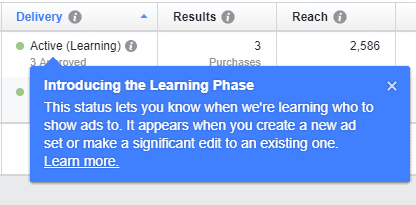Culture
Informative
Why Facebook’s Learning Phase influences optimisation
Nov 27, 2017
Informative
Nov 27, 2017
Have you ever wondered why your campaigns don’t get optimised instantly? This might be due to Facebook’s Learning Phase. Facebook simply needs time to look around for results instead of making decisions too fast and narrowing down optimisation to one specific group. In this blog we explain what the Learning Phase actually is and why you should care.
It’s the end of November, you launched your Christmas campaign already some weeks ago and are now desperately waiting for your campaign to get fully optimised. But how long must you wait until you can see an optimisation? How many results do you need so that Facebook can optimise your campaigns?
Facebook has a Learning Phase that has been part of the lifecycle of an ad set ever since. In this blog, we introduce you to Facebook’s Learning Phase and give you tips on how to crack optimisation.
When you deliver your ad set, Facebook still hasn’t got enough data to deliver it as stable as possible. Doesn’t matter if it’s at the start of your campaign or after you edit it. In fact, Facebook has to show ads to different types of people first. This way it can learn who is most likely to take the action you’re optimising for. This data collecting, experimentation phase is called the Learning Phase.

Whilst Facebook is collecting data and trying to find out the best way to deliver your ad set, you can expect more fluctuations than usual. In this phase, it is important that you don’t make any big changes in your ad set. If you make any significant edits during this crucial time, Facebook might have to start the whole Learning Phase all over again.Significant changes include any change to targeting or your ad creative, pausing your ad set, big change in the budget amount or bidding amount.
We’ve had loads of discussions about the number of results that Facebook needs to be able to optimise campaigns.
We’ve heard numbers such as 20 results per ad set, per day, per week.
But in Facebook’s recent revelation, it states very clearly that it needs at least 50 results to finish the Learning Phase.
As soon as Facebook has collected all the necessary data it needs, you will see fewer performance fluctuations in your ad set. If you like what you see – aka you are satisfied with your results – you can keep it running or increase your budget.
If you’re not happy with the performance, you can edit the ad set or pause it.
Let’s say your ad set doesn’t get 50 of the result it’s optimised for and the Learning Phase is over. Your ad set won’t get optimised or stabilised. If this happens we recommend the following:
Don’t see the Learning Phase as a waste of time or your next enemy. The Learning Phase is crucial for Facebook to be able to look around for results instead of making decisions too fast and narrowing down optimisation on one specific group.
The Learning Phase doesn’t necessarily impact delivery. What WILL impact delivery, however, is when your campaign is not getting the results that it was meant to bring.
In the eyes of Facebook, this will mean that the campaign and your ad set are not relevant to the target group and Facebook will make it harder to show your ad to the target group.